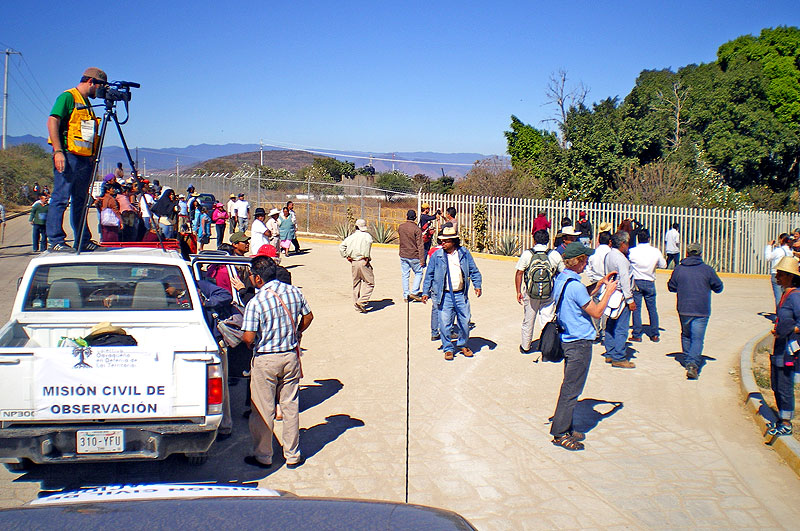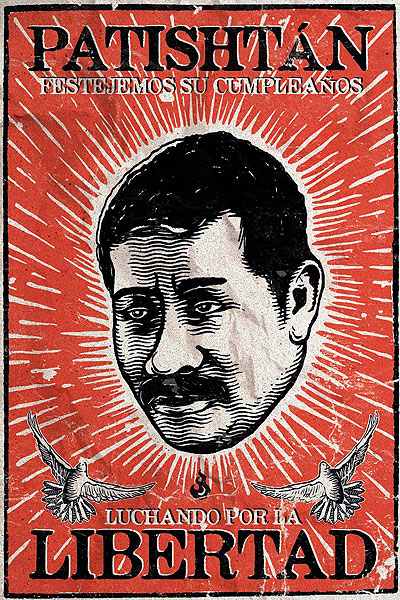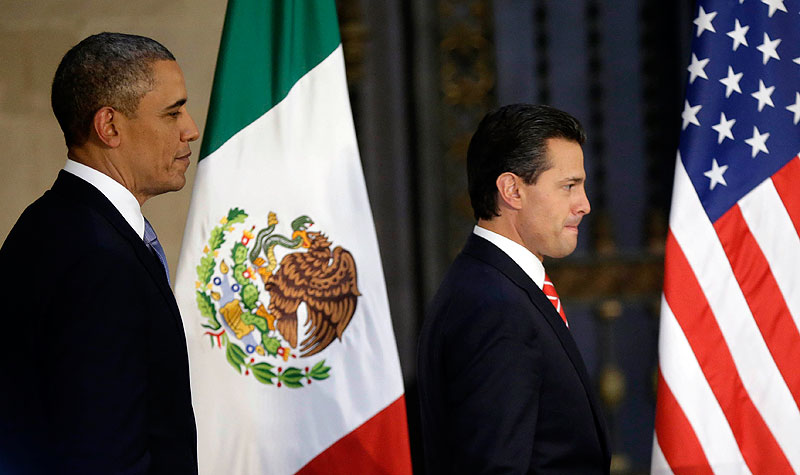The mining industry is one of the largest industries of the global economy. It is the mega project with the biggest social and environmental impact not only in Mexico but in the whole of Latin America and the rest of the world. Indigenous peoples and farming communities are the ones who see themselves most affected because it is mainly in their territories that natural resources are found. Mining has formed an important part of the worldwide economy since colonial times. In countries such as Peru, Bolivia and Mexico, the first successful attempts were made of extracting precious metals like gold and silver. However due to less developed methods for mineral extraction during those early times, the processes took much longer and impacts on the environment were much less severe. Currently, according to Gustavo Castro of the Mexican Network of People Affected by Mining (REMA), the extraction of silver during 26 months and that of gold during 6 months generates the same amount of these precious metals as during 120 years in colonial times.
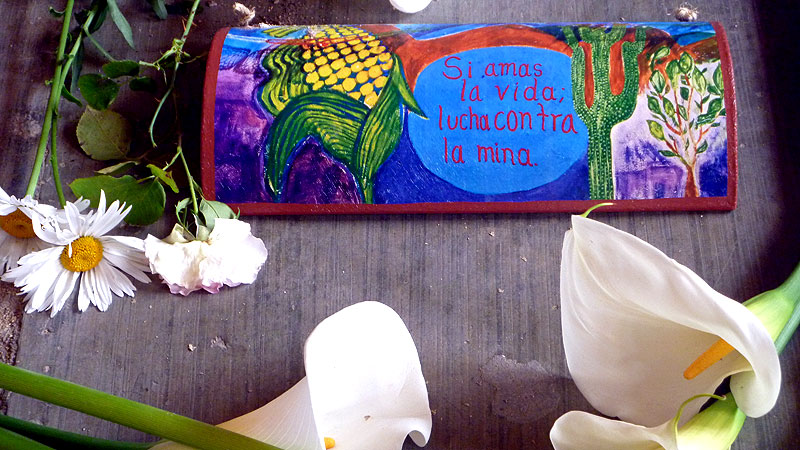
© SIPAZ
In Mexico, the mining sector holds 8% of the Gross Domestic Product (GDP). The country has taken the lead with having the highest sources of silver production and is a leading competitor for the production of zinc, copper and gold in the world. Hand in hand goes the fact that it has an enormously damaging impact on the environment and on human and animal life. Mining activity generates contamination of air, water and soil, and often generates a variety of health problems in the population living close to the mines. The problem is not the mineral in itself, but the model which sustains its industrialized extraction, according to critics who emphasize the unsustainability of the model. They state that it does not take into account environmental, cultural, social, economic or local aspects. Nor does it take into consideration the exhaustion and irreversible damage to the environment.
Mexican mining in a global context
In Mexico, during the Carlos Salinas de Gortari administration, in 1992, the reform of article 27 of the Constitution made it possible to exploit and concession minerals, although according to the Agrarian Law the owners of the lands are the ones who have to give permission to mining activity. According to REMA, the Mexican government, far from protecting, guaranteeing and promoting the human rights of the population, benefits and legislates in favor of the mining interests, systematically violating the human rights of the population. With the latest constitutional modifications concerning the issues of water, mining, agriculture and environment, amongst others, the federal government facilitates mining investments even more, not only in Chiapas but in the whole country.
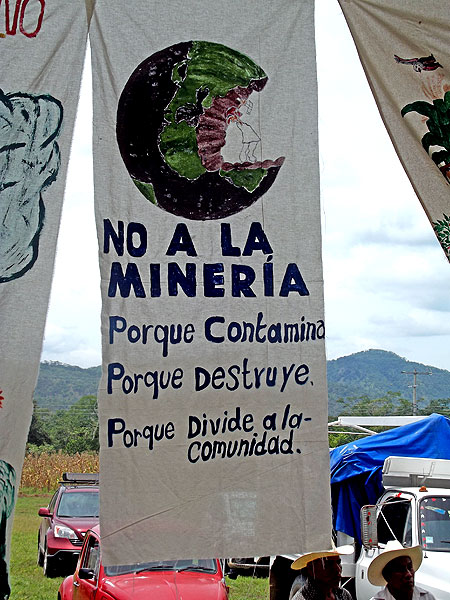
© SIPAZ
The members of REMA argue that domestic regulation is going to be adapted in the context of the Trans-Pacific Partnership Agreement (TPP). Since 2010, negotiations have been taking place for the TPP, which is a proposed free trade agreement under negotiation by (as of December 2012) Australia, Brunei, Chile, Canada, Malaysia, New Zealand, Peru, Singapore, the United States, Vietnam and Mexico. The TPP has received criticism and protest from civil society as well as elected officials because of the secrecy of the process, its expansive scope, and some controversial clauses in drafts leaked to the public. According to Public Knowledge (www.tppinfo.org), the TPP suffers from a serious lack of transparency and pressures foreign governments to adopt unbalanced laws. Anti-globalization advocates accuse the TPP of going far beyond the realm of tariff reduction and trade promotion, granting unprecedented power to corporations and violating consumer, labour, and environmental rights. For example, Rainforest Action Network (RAN), in an article of September 2012, mentions that “of the 26 chapters under negotiation, only a few have to do directly with trade. The other chapters enshrine new rights and privileges for major corporations while weakening the power of nation states to oppose them”.
Taking into account the importance of its mineral reserves, according to the Fraser Institute, Mexico holds the 24th place on a global level but it jumps to first place when it comes to the interests of mining enterprises worldwide. When it comes to foreign mining investment, Mexico is ranked as 4th in the entire world and 1st in Latin America, due to the fact that Mexico has no strict regulations for mining investments. The availability of energy and the existence of connecting highways facilitate mining activities as well as the fact that there are practically no conditions for how and what to extract from Mexican soil. Different actors confirm that this provokes the plundering of strategic minerals and threatens the maintenance of biological richness as well as Mexican culture. Although on a governmental level discussions are being held about reforming the Law on Mining, such an adaptation would probably still far from result in a halt to extraction of mining resources without regulation. The discussion is about the possibility of forcing mining corporations to pay 5% taxes over their income due to mining activities, as a way of compensation. The objective of this initiative is to transform part of the economic benefits of mining activities into benefits to the communities and regions where they take place. However, taking into account the enormous impact of mining companies on the quality of water, air, soil, landscape and the environment as a whole, especially on a local level, this can hardly be considered to be a reasonable compensation.
Interesting enough, according to a Deloitte report of May 2012, out of the 70% of foreign investment in Mexico, 75% of that is owned by Canadian owned companies. From a Canadian perspective, 44% of total foreign investment goes towards Mexico. The economic relationship between Mexico and Canada has strengthened since the signing of the North American Free Trade Agreement (NAFTA), in 1994.which allowed an easier process for exports and imports throughout North America without having to worry about taxes on imported and exported goods.
Mining and resistance in Chiapas
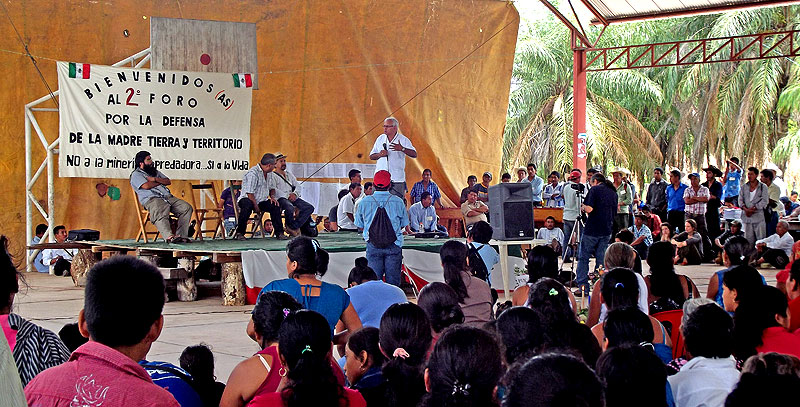
© SIPAZ
Almost all mining concessions in Chiapas were granted from 2000 to 2012, during the federal administrations of Vicente Fox and Felipe Caderón. The total number of mining concessions and activities of exploration and exploitation during this period have added up to 153 and are in the hands of either Mexican individuals, the federal government, Mexican or foreign companies. The total surface involved in these activities covers over 1.5 million hectares. This is to say that over 20% of the Chiapas territory is dedicated to mining interests.. The activities involved with mining have been taking place mostly in indigenous and farmers’ communities as well as territories with rich biodiversity. According to information of the environmental organization Otros Mundos, 54 mining projects have concessions for 50 years in a total of 24 municipalities in Chiapas. The concessions granted for open pit mining (for between 48 and 52 years) encompass over 10% of Chiapas territory.
Mining often leads to conflicts between the population and the corporation or authorities at different levels.in Chiapas, as well as in other parts of Mexico. A variety of problematic situations have occurred over the last decade These have included threats, persecutions, displacements of the population in mining areas, as well as assassinations of various leaders of movements against mining. This has resulted in the fact that, from 2007 onwards, people have started to organize themselves against mining projects in Chiapas. Various organizations, including REMA, Organización Campesina Emiliano Zapata (OCEZ), Organización Proletaria Emiliano Zapata (OPEZ), Frente Nacional de Lucha por el Socialismo (FNLS) and the Mesoamerican Movement Against the Extractive Mining Model (M4), amongst others, have started to organize meetings, mobilizations (including in front of the Canadian Embassy), blockades, campaigns and lawsuits for corruption against mining projects in Chiapas.
Canadian mining companies creating conflict in Mexico
Chicomuselo – Chiapas
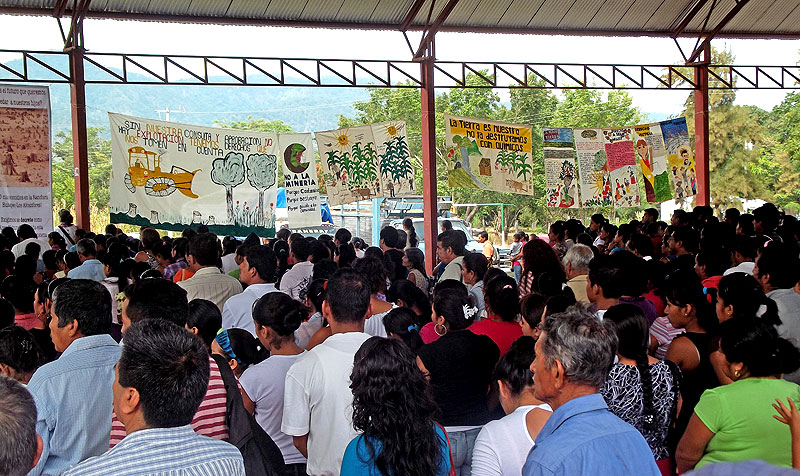
© SIPAZ
There have been many actions against the Canadian Exploration Company Blackfire, which purchased the mining concession in Chicomuselo. Throughout the different obstacles that Blackfire faces, the company continues to take pride in the different efforts towards community development, by claiming to have provided jobs for community members and had low effects on the environment. However, the communities in the region rose up in opposition to the exploitation of the land by Blackfire, which aimed to obtain the mineral barite. The people are against the mine because of the negative impacts on health and the environment. Many of the locals use the river as a place to bathe and wash their clothes, however, since the arrival of the mining company, many reported having skin irritations. Over 200 indigenous families were displaced, and of those families, only 25 men received jobs with the mine.
New issues surfaced after a leading activist against the mines, Mariano Abaraca, made mention to the Canadian Embassy about the intimidating tactics used by armed Blackfire workers. Tensions rose in August 2009 when Abarca was arrested, followed by 1,400 letters sent to the embassy expressing dire concern for Abarca’s life. Shortly after, in November 2009, Abarca was murdered by men who were known to have connections to the company, leading to the closure of the mine. There have been reports on corruption mentioning that the mayor ‘had been receiving personal payments from Blackfire’. Questions also arose upon the position of the Canadian Embassy. According to Mining Watch Canada, secret records show that the Canadian Embassy in Mexico provided an “active and unquestioning support” to the Canadian mining Company before, during and after the controversy surrounding the murder of Abarca.
These allegations need to be further investigated but it is clear that the people of Chicomuselo, until now, are maintaining their resistance. Four years after the assassination of Mariano Abarca, in February 2013, around 78 ejidos in 11 municipalities in the Coast and Sierra regions of Chiapas, formed their Civil Guardian groups against the entrance of mining corporations. Over 2.000 farmers, armed with machetes and sticks started this defense movement, called the Union of Peoples and Communities for the Defense of our Patrimony, Water and Environment, in the municipality of Motozintla, specifically detaining the mining corporations from entering the region. According to their demands, the movement will not cease until all exploration and exploitation permits in Chiapas are canceled.
San José del Progreso – Oaxaca
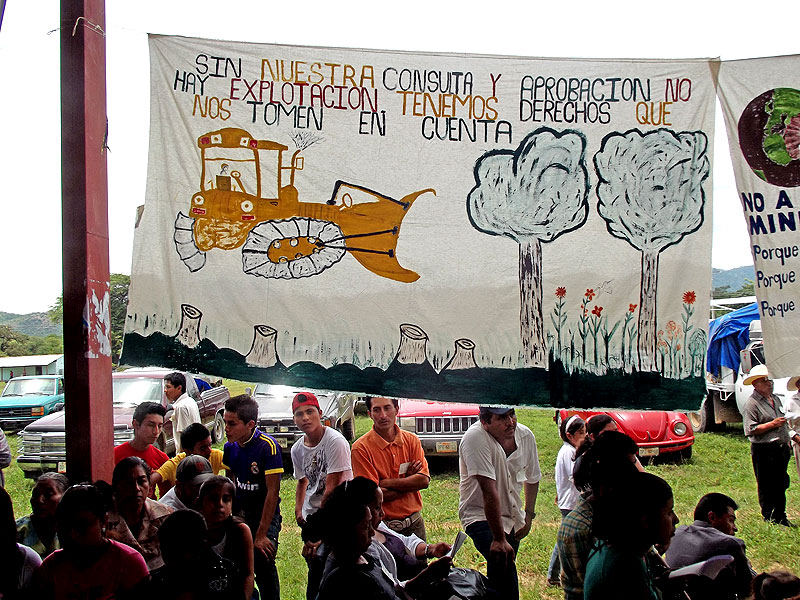
© SIPAZ
Not only in Chiapas people have started to rise up against mining activities.:In the state of Oaxaca there are various processes going on of people defending their territories against extractive mining activities. For example, in the municipality of San José del Progreso. Fortuna Silver, also a Canadian company, took interest in this region. The exploitation of silver and gold started in September of 2011. Ejido members were encouraged to apply for individual land titles through the PROCEDE program, This then made it easier for Fortuna Silver to gain authorization to use the land. According to information of the company, this happened via two public assemblies held by ejido members in 2006 and 2007. However, according to observations of community members the process was not transparent and reliable information was lacking.. As one woman mentioned: ‘In town meetings the previous municipal president, Amadeo Alejo Vasquez Rosario never told people what he was doing. He just said he was giving permission for a garbage dump. We finally realized the dump was actually a mine concession. By that time some people had already agreed to sell their ejido land’.
Notwithstanding some community initiatives proposed by Fortuna, the community rose in opposition to the mine and in 2009 created a blockade at the point where the road provided access into the mining concession. Three months later, Governor Ulises Ruiz sent 700 police officers to terminate the blockade which led to the arrest of 23 people. The following year the resistance persisted which then led to the disappearance of a local priest, Martín Octavio García Ortiz, who was kidnapped, beaten and forced to leave town. The community requested the State of Oaxaca to cancel the concessions, but a few months later the mine opened.
In January 19, 2012 tensions and conflicts reached new heights. Bernardo Méndez, an activist from the community, was shot and killed, along with Abigail Vásquez, who was shot and seriously wounded. Threats were made through vandalizing common places that locals attend, including one graffiti specifically mentioning Bernardo Vásquez Sánchez, an outspoken opponent of the Fortuna mine, saying ‘Bernardo, your end has come’. Shortly after, Bernardo Vásquez Sánchez was shot and killed on the highway just outside of San José. Since these two murders, there have been sneer campaigns saying that Vásquez had made deals with Fortuna Silver. The mayor of San José del Progreso, Alberto Mauro, accuses members of the Coordination of the Peoples of the Ococtlán Valley (CPUVO) of having murdered one of the Bernardos attempting to distance himself from the violent happenings. As time goes on, the violence continues to escalate, more blockades have been held and there have been more attacks leaving two members of the CPUVO, Guadalupe Vásquez Ruiz and Bertín Vásquez Ruiz, shot and wounded on June 16th, 2012. However, the people opposed to the mining activities continue their struggle advocating for the human rights they have been denied.
Carrizalillo, Guerrero
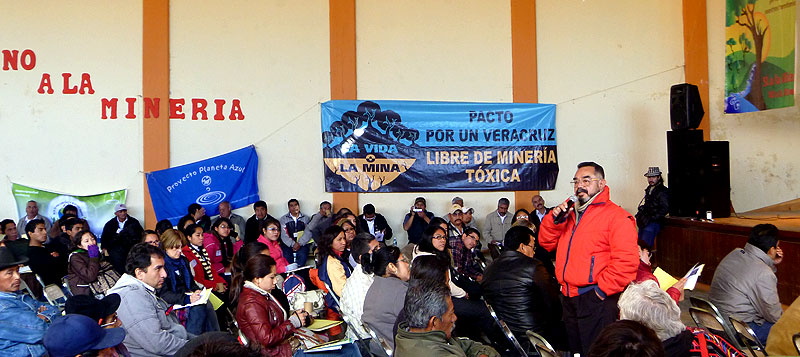
© SIPAZ
When Los Filos, a branch of the Canadian mining company GoldCorp, first came to Carrizalillo, the people, who are organized in the Permanent Assembly of Landowners and Workers of Carrizalillo (APETC) were open to the idea of having the mine come to their land, because they hoped the company would provide new income generating opportunities. Valeriano Celso Solis, a representative of APETC, declared ‘We did not know about the damages this would cause. We made errors due to ignorance because we did not study the facts, but we decided to organize as people. We wanted to avoid destruction of the hills, but the only thing left to do was repair the damage’.
After a negotiation process, the people left with the sense of accomplishment with the settling rent price of $500 USD/hectare of land, although initially they had asked for 700 USD. Once the company began the exploitation process, a new array of problems arose, not only did the company fail to follow through with their agreement on rent but many health and environmental issues followed. The exploitation led to devastation of the land, making it impossible to cultivate. Those who were hired by Los Filos lacked the labor rights they were entitled to. Valeriano Celso stated ‘we did a sit in and in response the State Government sent us the police, several community members were arrested and imprisoned’.
The APETC began searching for alternative actions against the mining company. They sought for legal action and connected with the Tlachinollan Human Rights Center, who supported the case nationally and internationally. As Valeriano Celso mentioned ‘Corporations take advantage of the difficulties in organizing, there was never a formal agreement from the entire population. There are people for and against the project. The companies benefit from the fact that there is no one to advise us”. Now, 8 years later there are new companies that are exploring this community to carry out the mining opportunities to which it holds. The community of Carrizalillo continues its resistance towards the mine, but the problem of not being fully organized from the start has hindered their chances of regaining what was once theirs.
Post extractivism as an alternative to the Extractive Mining Model?
Numerous environmental groups, human rights organizations as well as the anti-capitalist movement have criticized the extractivist model indicating that it is ecologically destructive and keeps the people in many countries in misery, dependence and underdevelopment. Taking into account the negative consequences of the Extractive Mining Model, activists and academics have come to the conclusion that the model is unsustainable and have started to discuss viable alternatives to it.
A transition from the extractivist model towards a whole other system, proposed by left-wing and anti-globalization advocates, is the post-extractivist model. In post-extractivism, natural resources would be used in a rational and sustainable manner, and mainly for local use, facilitating a mostly national economic development. Among indigenous peoples’ movements, the post-extractivist posture is reflected in the philosophy of “lekil kuxlejal” or “living well”, roughly meaning having access to what is needed according to a moderate way of living.
This transition would confront enormous challenges on social as well as cultural and political levels. The ecologist Eduardo Gudynas argues that programs will need to reform consumer patterns, in favor of the development of products with longer duration and better balance between energy and material, as well as to promote recycling, product sharing and reuse. On a political level, the transitions require the strengthening of a democratic framework including adequate social participation. Post-extractivism does not mean prohibiting all extractive forms but it does imply radical changes concerning ideas about what development means, and productive processes having to be oriented towards securing people’s necessities while conserving nature, instead of towards profitability.
***********
According to Cesar Padilla, of the Latin American Mining Conflicts Observatory (OCMAL), the model of post-extractivism is starting to be part of the discussions on the failure of extractivism as a development model. Communities affected by mining are starting to demand the restriction and even the prohibition of mining as a central model of development throughout Latin America. An example is formed by the demands of the Believing People of Chiapas, an organizational process associated with the diocese of San Cristóbal de Las Casas, who include the mining project in what they call “projects of death”. During a pilgrimage on the 25th of January of this year, the denounced “the concessions for mineral exploitation that the federal government has awarded, particularly to foreign firms, thus totally violating the peoples’ fundamental right to prior informed consent”. Another clear example of struggle against mining form the firm words of a woman from San José del Progreso: “Even though a “compañero” has died, it doesn’t mean that we are going to stop our struggle. On the contrary, it gives me more strength to keep fighting. I have hope that one day this mining company is going to get out of this community. I have hope that one day they will stop using our natural resources and that we will be able to save them. We are the ones who need these resources. The people and companies that come to our community want our resources so that they can enrich themselves – not because they really need them”.

